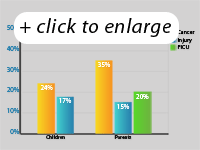An extensive reading and reference list is available by clicking here.
Click here for more details.
A recent meta-analysis found that the prevalence of significant traumatic stress symptoms averaged 20% in studies of injured children and 12% in studies of ill children. Similar rates of traumatic stress symptoms are reported in the parents of ill or injured children (Kahana, et al. 2006).
Risk factors for persistent traumatic stress reactions include prior traumatic experiences or behavioral problems, more severe pain or exposure to frightening sights and sounds while in the hospital, subjective sense of life threat and injury / illness severity, and more severe early traumatic stress reactions. Parent presence and support, as well as a positive peer support system, appear to serve as protective factors.
Click here for more details.
Research in this area has made promising steps toward developing and evaluating screening tools, preventive interventions, and treatment interventions.

Promising screening tools have been developed to identify injured children at higher risk for persistent traumatic stress, and families of children with cancer with greater need for psychosocial support.
Programs of preventive intervention for families of children with a new cancer diagnosis, and children hospitalized for traumatic injury, have been developed. Preliminary evidence supports the utility of these interventions, and more studies are underway.
Research data supports the use of treatment programs specifically designed to address cancer-related traumatic stress in teen cancer survivors and their families, and cognitive-behavioral therapy for children with traumatic stress related to acute medical events.
Traumatic stress reactions associated with pediatric medical events were described initially in the mid-1980s.
The first large multi-site study of childhood cancer survivors was completed in the mid 1990’s and highlighted the significance of traumatic responses in the survivors’ mothers and fathers (Kazak et al, 1997). The first studies documenting traumatic stress symptoms after pediatric injury were conducted in the late 1990’s (DeVries et al. 1997; Daviss et al. 2000).
The research literature in this area is growing -- published papers related to pediatric medical traumatic stress increased eightfold in the period 2000-2007 over the preceding decade.




